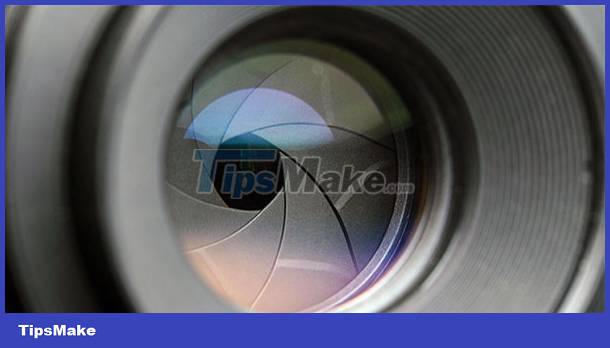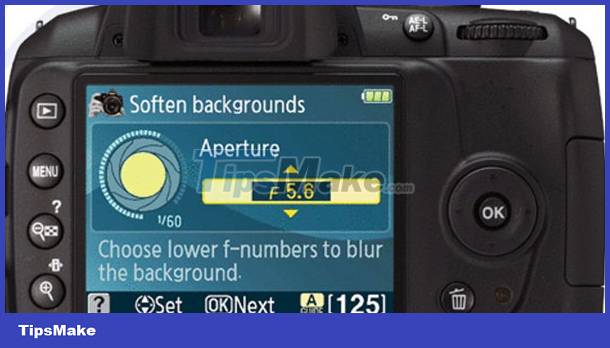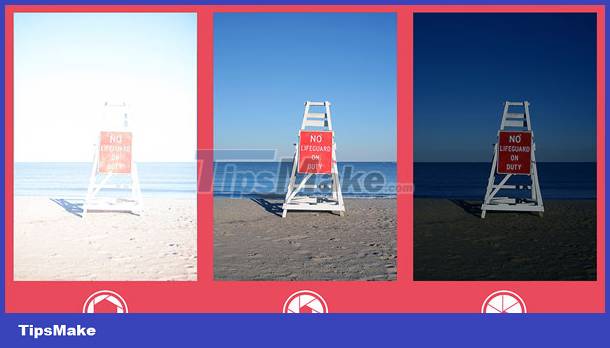Learn about aperture in digital photography
In traditional photography - film cameras, aperture - Aperture is a parameter that indicates how wide the lens is to allow film to be exposed to the scene being captured. Aperture in digital cameras is similar, it is one of the three important parameters to help you take high-quality photos. The other two important parameters are Shutter Speed and ISO .
 Aperture - Aperture in digital photography
Aperture - Aperture in digital photography
Aperture - Aperture in digital photography
When you press the digital camera's shutter button, a door - the shutter opens allowing the camera's sensor to capture the image you're trying to capture. Its small or large opening is called aperture - Aperture. The larger the door opening, the more light comes in, the smaller the opening, the less light comes in. Simply put, aperture is how large the lens opens when taking a photo.
Aperture is measured in F-Stop, in technical photography you often see f/numeric specifications such as f/2.8, f/4, f/5.6, f/8, f/22,. Each value is called F-Stop. Each F-Stop doubles or halves the aperture of the lens, equivalent to the amount of light the image sensor receives. Remember that every time you increase or decrease the shutter speed - Shutter Speed also changes the amount of light accordingly.
One thing that many people often confuse is that a large aperture - a large aperture will capture more light is a small F-Stop number, and conversely a smaller aperture - a small aperture will capture less light is F-Stop has a larger number. So in reality f/2.8 is a much larger aperture than f/22. It may sound counterintuitive at first, but you'll get the hang of it.
 The larger the aperture, the smaller the F-Stop
The larger the aperture, the smaller the F-Stop
How to set the aperture of a digital camera
Digital cameras do not always allow you to change the aperture setting, especially when shooting with automatic modes - Auto Mode or preset - Scene Mode.
When you want to set the aperture, switch to the mode that allows you to choose the aperture yourself by exiting the auto mode - Auto and switching to one of the manual shooting modes - Manual, aperture priority - Aperture Priority, speed priority - Shutter Priority or program - Program.
Aperture-priority or manual shooting modes are often used when you want to change the aperture.
For regular cameras, you probably need to go to the settings menu - Menu and navigate to the settings for aperture. Then select the aperture value you want or choose auto.
For higher-end cameras, there will probably be a dedicated Aperture button on the camera. Simply press it and rotate one of the dials to change the camera's aperture setting.
Some other cameras may have a lens that can change aperture, you just need to rotate the lens to select the aperture you want to shoot.
 Setting the aperture on a digital camera
Setting the aperture on a digital camera
If you don't see a button labeled Aperture, it's still possible that your camera will allow you to program it to turn a multifunction button into an Aperture button. See the manual that came with your digital camera for how to use it.
Matters needing attention when choosing a shooting aperture
When considering to choose the aperture to take a photo, you should always pay attention to the exposure of the photograph. You shouldn't think that aperture can be used on its own without regard for the other two factors in the exposure triangle: shutter speed - Shutter Speed and light sensitivity - ISO. When changing the aperture, you also need to change one or both of these factors to compensate for the light of the balanced image.
For example, if you slow down your aperture from f2.8 to f4.0 you are halving the light, to compensate for this you may need to slow down your shutter speed by a notch, for example. from 1/60 to 1/30. Other changes that can be chosen are to increase the light sensitivity - ISO to a higher level, for example from ISO 100 to ISO 400.
 Compare photos taken with different apertures
Compare photos taken with different apertures
Depth of field and aperture in digital photography
There are many things you need to keep in mind when changing the aperture, but one of the most important is the depth of field.
Depth of Field, abbreviated as DOF , it is the distance of the focus area when taking a picture. The large depth of field means that almost everything in the frame will be clear, whether near or far from the shooting position. A small or shallow depth of field means that only part of the image will be sharp, the rest will be blurred.
Aperture has a big impact on depth of field. A large aperture, remember that having a smaller number will reduce the depth of field while a small aperture - having a larger number will give a greater depth of field.
This is a bit confusing but keep in mind that if the aperture has a small number, the depth of field is small, and if the number is large, the depth of field is large.
Take a look at the two illustrations below. The photo on the left was taken with an aperture of f/22 and the photo on the right was taken with an aperture of f/2.8 . The difference is pretty obvious, the photo on the left has both flowers and buds in focus including the leaves and hedges behind in the background. The photo on the right has only the flowers that are clear, but due to the small depth of field, the rest is not clear due to the distance from the camera when shooting.
 Difference in depth of field
Difference in depth of field
The best way to understand aperture is to take pictures outside, experiment with positions with many subjects a distance from each other from near to far, and take photos with variable apertures from smallest to largest. . You will quickly notice the changes when adjusting the aperture.
Some shooting styles require a large depth of field - a small aperture. In most landscape shots, for example, you'll find photographers often shoot with small apertures - large numbers. This is to ensure that the horizon line in the background is clear.
On the other hand, when shooting portraits, you will find it very useful when you just want to make the subject in focus and the background will be blurred to ensure that your main subject stands out from the rest. In this case you need to choose a large aperture - a small number to ensure a small depth of field.
Macros - Macros are often used by many people with large apertures to ensure that the main subject is in focus to fully focus the viewer's attention on it while the rest is removed from the clear area. sharp.
You should read it
- 10 tips for taking beautiful photos with digital cameras
- How to get photos from digital cameras
- Learn about white balance - White Balance in digital cameras
- 6 tips to help take better night photos with a popular digital camera
- Basic guide when buying digital cameras
- Basic operations to have a beautiful digital photo
- Should you choose a digital camera?
- Memories in a shoebox: Digitizing old photos unlocks a flood of mixed emotions
May be interested
- Do you choose a large aperture or a large sensor when taking photos?
 usually when taking photos in low light conditions, you often choose a lens with a large aperture and accompanying a large size sensor. of course, with such a choice you will easily take more photos, but it is imperative that we carry a bulky camera, a larger lens and the price is not easy to breathe. so where is the reasonable choice?
usually when taking photos in low light conditions, you often choose a lens with a large aperture and accompanying a large size sensor. of course, with such a choice you will easily take more photos, but it is imperative that we carry a bulky camera, a larger lens and the price is not easy to breathe. so where is the reasonable choice? - What is exposure and exposure triangle in photography?
 the term exposure exposure is something that anyone who starts learning photography needs to learn. so that we can understand the exposure will control the image better.
the term exposure exposure is something that anyone who starts learning photography needs to learn. so that we can understand the exposure will control the image better. - How to take clear digital photos
 clear digital photography is what all photographers want
clear digital photography is what all photographers want - Learn about white balance - White Balance in digital cameras
 learn white balance knowledge - white balance in digital cameras will help you know how to take good photos
learn white balance knowledge - white balance in digital cameras will help you know how to take good photos - 5 types of photos ideal for those who like to travel
 feet first, follow me, lens between us, lego travelers and #brinsonbanksing are very impressive shots that you should not ignore.
feet first, follow me, lens between us, lego travelers and #brinsonbanksing are very impressive shots that you should not ignore. - Shadow in photography
 in photography, mastering light is an important premise to get a beautiful picture and one of the beauty that light creates is shadow.
in photography, mastering light is an important premise to get a beautiful picture and one of the beauty that light creates is shadow. - 3 apps to help you learn to take photos with your smartphone
 these apps not only help you improve your skills, but also inspire your next great shot while you practice.
these apps not only help you improve your skills, but also inspire your next great shot while you practice. - 10 best smartphone photography today
 tipsmake - according to the rankings of dxomark, huawei p20 pro, apple iphone xs max, samsung galaxy note 9, xiaomi mi mix 3 are the phones with the highest dox points.
tipsmake - according to the rankings of dxomark, huawei p20 pro, apple iphone xs max, samsung galaxy note 9, xiaomi mi mix 3 are the phones with the highest dox points. - The harsh truths in photography
 photography is a job that requires passion, talent, and experience to be drawn through photography. taking photos gives people joy and creativity when expressing their abilities in each photo.
photography is a job that requires passion, talent, and experience to be drawn through photography. taking photos gives people joy and creativity when expressing their abilities in each photo. - Using digital camera shooting modes
 if you know how to use the shooting modes of a digital camera, you will get better photos
if you know how to use the shooting modes of a digital camera, you will get better photos










 Should you choose a digital camera?
Should you choose a digital camera? How to choose a universal digital camera
How to choose a universal digital camera How to choose a semi-professional digital camera
How to choose a semi-professional digital camera Using a digital camera for beginners
Using a digital camera for beginners Setting the parameters of the digital camera
Setting the parameters of the digital camera